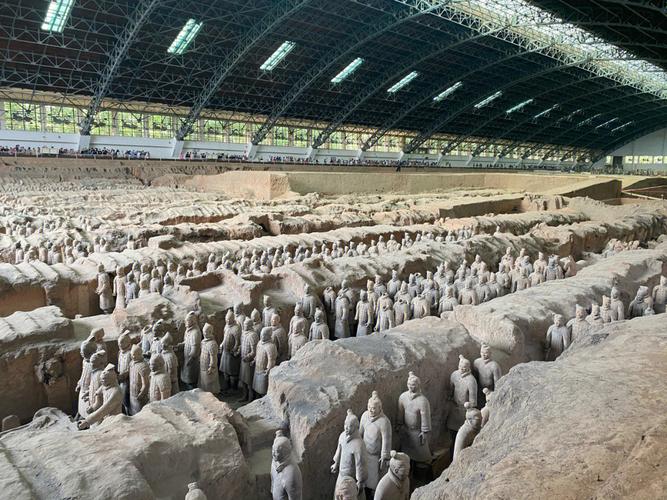
Facts about the Mausoleum of Qin Shi Huang and Its Museum
The Largest Preserved Site in China
The Mausoleum of Qin Shi Huang is not just a tomb, it's a sprawling necropolis and a testament to the power and ambition of China's first emperor. Located in Lintong District, about 35 kilometers east of Xi'an, Shaanxi province, the site is the largest preserved mausoleum complex in China, covering an astonishing area of 56.25 square kilometers.
To put this into perspective, the entire area within the outer walls of the mausoleum complex is a staggering 2.13 square miles larger than the island of Manhattan! Within this vast area lies a treasure trove of historical and archaeological significance, providing invaluable insights into the Qin dynasty (221-206 BC) and the vision of its founder, Qin Shi Huang.
A Unique Architectural Ensemble Mirroring Xianyang
One of the most remarkable features of the mausoleum complex is its layout. It wasn't simply designed as a tomb but as a microcosm of the emperor's power and the empire he ruled. The architectural ensemble deliberately echoes the urban plan of Xianyang, the Qin dynasty's capital city.
This meticulous mirroring was no accident. The innermost part of the complex, housing the emperor's burial mound, represents the imperial palace. Enclosing this sacred area is a series of inner walls, symbolizing the protective walls of Xianyang itself. Finally, an outer wall encircles the entire complex, representing the grand boundaries of the empire Qin Shi Huang had so forcefully unified.
This deliberate mirroring of the capital city within the mausoleum complex underscores the absolute power Qin Shi Huang wielded in life, a power he clearly intended to carry into the afterlife.
More Than Just a Tomb: Exploring the Subterranean City
While the immense scale and architectural design of the mausoleum are impressive, it's what lies beneath the surface that truly captivates the imagination. The heart of the complex is the subterranean palace, the final resting place of the emperor himself. Though the central tomb chamber remains unexcavated, historical records and archaeological investigations provide a glimpse into its splendor.
Ancient texts describe a tomb of unprecedented opulence, its ceiling adorned with celestial maps and the floor laid out as a map of the empire, with flowing mercury representing its mighty rivers. This subterranean city was also meant to be populated, not with the living, but with an army of terracotta warriors.
The Terracotta Army: Guardians of the Afterlife
The discovery of the Terracotta Army in 1974 catapulted the Mausoleum of Qin Shi Huang to international fame. These life-sized terracotta figures, each uniquely crafted with individual features and attire, were stationed in military formation within vast pits near the emperor's tomb. Numbering in the thousands, these silent sentinels were tasked with protecting Qin Shi Huang in the afterlife.
The sheer scale and artistry of the Terracotta Army is breathtaking. The meticulous detail in each figure, from their armor and weapons to their facial expressions, speaks volumes about the skill of Qin dynasty artisans and the importance placed on equipping the emperor for eternity.
The Mausoleum Museum: Unveiling History
To showcase the wonders of this archaeological treasure trove, the Museum of the Mausoleum of the First Qin Emperor was established. This museum serves as the primary point of access for visitors to learn about the history of the Qin dynasty, the construction of the mausoleum, and the significance of the artifacts unearthed.
The museum's vast collection includes not just terracotta figures but also bronze chariots and horses, weapons, jade ornaments, and other artifacts that shed light on the daily life, rituals, and military might of the Qin era. Through these remarkable objects, the museum offers a window into a pivotal period in Chinese history.
Q&A
Q: Why wasn't the central tomb of Qin Shi Huang excavated yet?
A: The central tomb remains unexcavated due to a combination of factors. There are concerns about the preservation of its contents, particularly the legendary mercury rivers. Additionally, the current technological capabilities might not be sufficient to excavate and preserve the tomb without causing damage. Finally, there are ethical considerations surrounding the disturbance of an emperor's final resting place.
Q: What is the significance of the terracotta army?
A: The terracotta army served multiple purposes. Primarily, they were meant to protect and serve the emperor in the afterlife. Their presence also reflects the importance placed on military might during the Qin dynasty. Moreover, the unique features and attire of each figure provide valuable insights into the military hierarchy, armor, and weaponry of the time.
Q: Is the Mausoleum of Qin Shi Huang recognized by any international organizations?
A: Yes, the Mausoleum of Qin Shi Huang, including the Terracotta Army, was designated a UNESCO World Heritage Site in 1987, recognizing its outstanding universal value and significance to human history and culture.